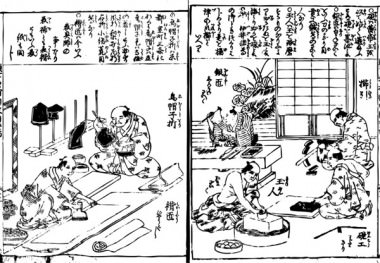The craftsman who makes a comb, an inkstone, and a ball, and the craftsman of silverwork are drawn on the right.
It seems that “koutei makes an inkstone from a ball and an inkstone is called Bokuchi” is written about “the inkstone (inkstone)” although it cannot read well.
However, I think that it is a reading mistake since a meaning does not pass.
“銀匠 (Ginsyou)” is a craftsman who builds silver work, and makes decoration 目貫 (Menuki: nail which fixes a blade and a handle) and the needle of a sword.
“玉人 (gyokujin)” is craftsmen who polish a ball.
It is said that the ball originating in the sea is called “珠(Jyu)” although the portion of “玉 (Gyoku)” cannot be read.
although it seems that what “only the averages are things if compelled” used was called “爪櫛 (Tumagusi)” of “楊津 (Yuzu)”, or it had withered in the place of “the comb”, the anecdote about 楊津 was not found.
The hat craftsman and the mounting craftsman are drawn on the left.
“烏帽子折(Ebosiori)” in Muromachi of Kyoto, the high person of grade putting on formal headgear for court nobles, and “立烏帽子 (Tate-ebosi)”, as three articles were suited, It is said that there are kinds, such as “風折 (Kazeori)”, “梨折 (Nasiori)”, “左折 (Hidariori)”, “右折 (Migiori)”, “小結 (Koyui)”, and “荒目 (Arame).”
“褙匠(Heisyou)” is a picture framer who says in now.
It is said that it is also called “表補 (Hyouho)” and “表褙 (Hyouhei)”, and a “cover” is the same.
右には櫛や硯や玉を作る職人と、銀細工の職人が描かれています。うまく読めないのですが、「硯(すずり)」に関しては「硯は黄帝が玉で作り、硯を墨池という」と書かれているようです。しかし意味が通じないので、読み間違いだとは思います。「銀匠(ぎんしょう)」は白金(しろかね)細工をつくる職人のことで、刀の飾り目貫(めぬき:刀身と柄を固定する釘)や鍼(はり)を作ります。「玉人(ぎょくじん)」とは玉を磨く職人のことです。「玉(ぎょく)」の部分は読めないのですが、海に由来する玉を「珠(じゅ)」と言うそうです。「櫛(くし)」のところでは、「いざなみのみこと」が使ったものを「楊津(ゆづ)」の「爪櫛(つまぐし)」というとかかれているようですが、楊津に関する逸話は分かりませんでした。
左には帽子職人と表具職人が描かれています。「烏帽子折(えぼしおり)」は京都の室町三条にあったようで、「立烏帽子(たてえぼし)」は位の高い者が身につけ、「風折(かぜおり)」「梨折(なしおり)」「左折(ひだりおり)」「右折(みぎおり)」「小結(こゆい)」「荒目(あらめ)」などの種類があるそうです。「褙匠(へいしょう)」は今で言う表具師のことで「表補(ひょうほ)」とも「表褙(ひょうへい)」ともいい、「表紙(ひょうし)」も同様だそうです。

